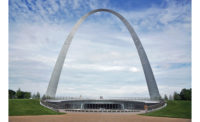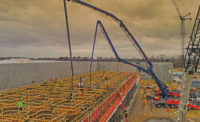The largest public-private partnership investment in a national park is delivering a new experience for visitors to the landmark Gateway Arch in St. Louis, which was designed by the late-architect Eero Saarinen. The 10-year path to the opening this month was full of hurdles, including floods. And the project’s 46,000-sq-ft underground visitor center expansion needed to be built without shutting down the arch, which gets nearly 3 million visitors each year.
After a $380-million park redesign that includes the visitor center expansion and a land bridge across the highway, the recently renamed Gateway Arch Park finally has a walking path to the Old St. Louis Courthouse and the rest of downtown.
“Making that connection to the city was really fundamental to the project,” says Eric Moraczewksi, executive director of the Gateway Arch Park Foundation, the nonprofit that began the process for the development more than a decade ago.
Saarinen died before construction of the arch was completed in 1965, and the pedestrian bridges he designed to connect it to downtown St. Louis “got value engineered out,” Moraczewksi says. “A lot of what we’re doing is not recreating the wheel, but just realizing Saarinen’s original vision, which was this connection, creating an iconic entrance to such an incredible monument.”
In 2015, general contractor KCI Construction Co. finished a $26-million contract with the Missouri Dept. of Transportation to build the Park Over the Highway—a 300-ft-wide, 1,200-sq-ft-long pedestrian bridge that connects the arch to downtown. As a national park that is also on the National Register of Historic Places, there were stringent demands on how the landscape could be built, what materials could be used and how much existing structures could be changed.
“They were looking for a kind of minimal impact on the landscape,” says Scott Newman, managing partner at Cooper Robertson. “We had to work with the Missouri State Historic Preservation Office to review proposals to make sure that we weren’t negatively impacting the historic resource.”
“It does have a very light touch on the landscape,” he adds. “We were very careful not to change or have as little change as possible to the grading, the berms, the shape of the landscape.”
The design of the visitor center that was eventually selected used stainless steel and glass to open up the arch as its new entrance, while 91 acres of public park and the footbridge created a connection to the Old Courthouse and a new public park space behind it.
Video courtesy of EarthCam
New Connection
CityArchRiver Foundation—which eventually became the Gateway Arch Park Foundation —and other community and public groups raised $221 million in private money for the project, which includes 70 acres designed by Michael Van Valkenburgh & Associates. Inside the new visitor center, 46,000 sq ft of new exhibit space has been added. The design team of Cooper Robertson, James Carpenter Design Associates and local firm Trivers Associates won the project along with MVVA.
“The design team really regarded the Gateway Arch as a really important work of public art that has a lot of national meaning, in some ways even equated with the Statue of Liberty,” says Newman.
Designing in the shadow of the arch was challenging and demanded not just design excellence but also the use of appropriate materials to lend “a kind of permanence and timelessness to really amplify the meaning of the arch in a way that doesn’t imitate it but refers to it in a respectful way,” he says.
Moraczewski notes that the foundation had very little information to go on for how to proceed, as a public-private partnership like this had never invested such a sum in an existing park before. Before the process of raising funds and asking for designs even began, many local leaders were calling on politicians to try to get a renovation passed as part of a bill in Congress so federal tax dollars would pay the cost.
“When you think about the renovation of 91 acres, the addition of 46,000 square feet to the visitor center, the renovation raising the riverfront, and then the renovation of Kiener Plaza, which is a city park, as a part of this project, you get the scale,” Moraczewski says.
The project also received TIGER grants that went toward MoDOT’s bridge project as well as road projects that elevated 1.5 miles of land along the Mississippi River by as much as 3 ft. The $33-million MoDOT road project eliminates up to 70% of floods that close down the riverfront, according to Great Rivers Greenway.
“We weren’t going to necessarily get the attention from the federal government or state government,” says Joel Fuoss, a principal of Trivers Associates. “[The Gateway Arch Park Foundation] kind of took it upon themselves to figure out a way to get it done.”
Fuoss says the P3 bringing together several different agencies including MoDOT, the Great Rivers Greenway and the National Park Service was a model for other municipalities to bring together local groups and state and federal agencies to accomplish big projects.
Open During Construction
Waiting for funding from a tax increase, approvals from the National Park Service and the Missouri Historic Preservation Office all took time. Design documents for the visitor center were not finished until 2014. That left one year to complete civil work, landscaping demolition and construction of the $96-million visitor center expansion before the arch’s 50th birthday in 2015.
Two of the aforementioned floods happened in 2015 and put up another hurdle by washing away the east slope of the center’s site and part of the site of the demolished parking garage. There was no possibility of finishing the project in one year, so the team from visitor center general contractor McCarthy Building Cos. and the Gateway Arch Park Foundation regrouped and shot for 2018.
“We had to be able to construct the new museum and renovate the old museum while carefully interacting with visitors and simultaneously having hundreds of dump trucks coming into and out of the site every day,” says Ryan Freeman, vice president of operations at McCarthy. “We excavated 300,000 cubic yards of material to dig down to the foundation wall of the existing museum.”
McCarthy staged the project so that the waiting lines for rides to the top of the arch or museum exhibits were never closed. They separated off the area near the arch tram from the rest of the site.
Freeman says the height of the visitor center’s gently sloping wall made the project a difficult concrete job, which McCarthy self-performed. The tallest wall was 41 ft, but most ranged from about 25 ft to 35 ft. All of the walls slope inward from the park, along with the new landscape, and had to be matched perfectly during pours for final positions. Instead of using natural fill, crews used lighter-weight geofoam blocks to create the look and feel of a gently sloping hill that links the footbridge to the visitor center and then the arch below. The geofoam blocks were placed on the north and south side of the entry level in early April 2017 and then covered in soil to create the look of a natural slope back to the arch.
“They kind of go together like Lego bricks,” says Andy Poirot, project director at McCarthy who led the visitor center team. “We had steps at locations that needed infill to make a smooth transition. Eventually it gets covered by the soil and allows that whole grade to take on the natural shape of the earth.”
The renovation of the existing museum allowed the foundation to add a gift shop while also expanding the exhibits. New mechanical, electrical and plumbing lines and a mechanical room were also part of the addition. All granite and stone in proximity to the original visitor center was matched to existing materials.
“We wanted to make sure that this was a park that people would be proud of 20 years from now and 30 years from now,” says Moraczewski. “When the vote for the sales tax came in at 70%, that really told us the community wanted this to happen.
“Not every voter in the community is capable of making transformational gifts, and this is the largest amount of dollars to ever go into a national park site, and that’s what we represent,” he adds. “Those people are choosing to tax themselves through a sales tax and they’re saying ‘This is important, this is what matters to me.’”











Post a comment to this article
Report Abusive Comment